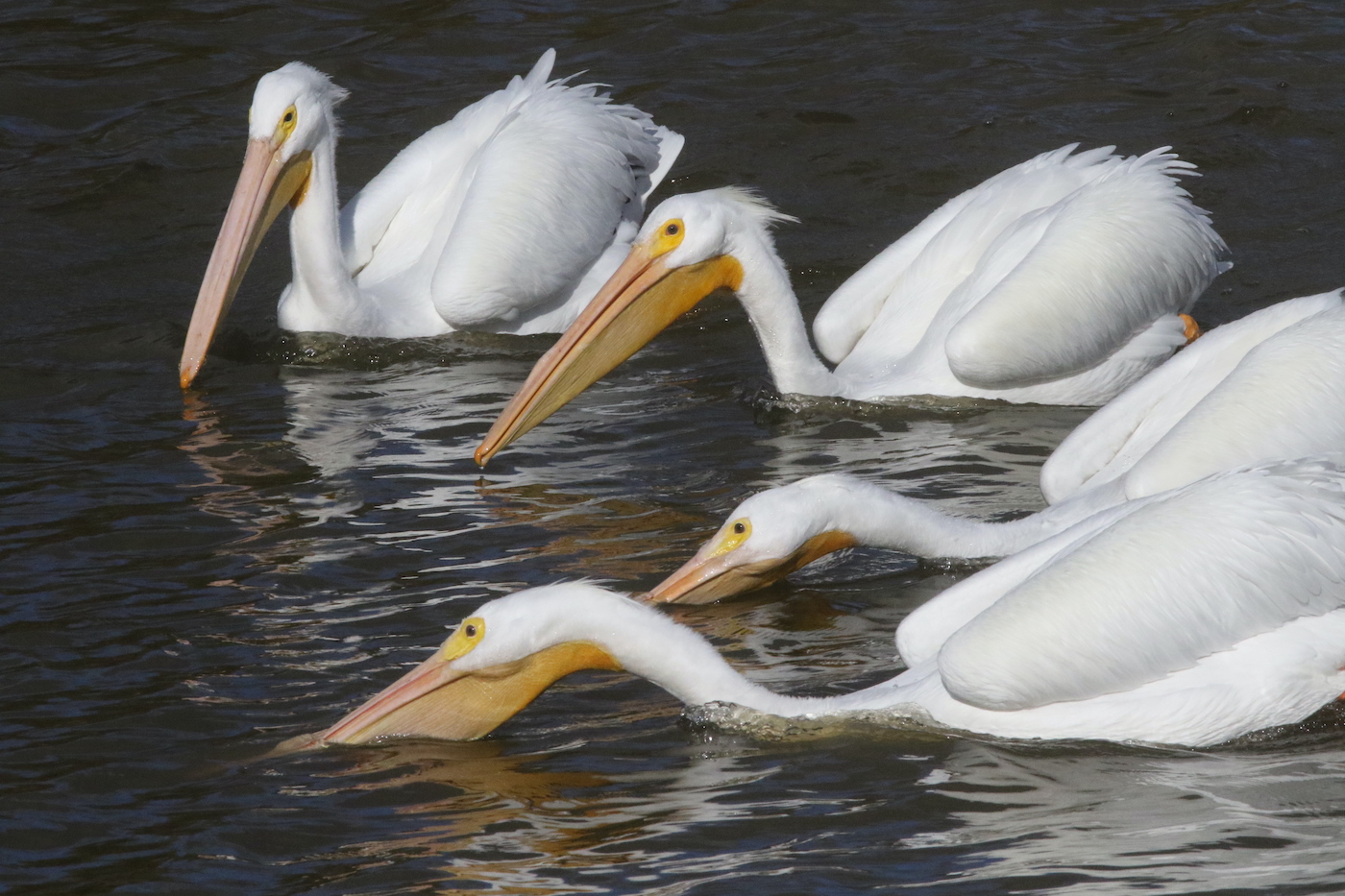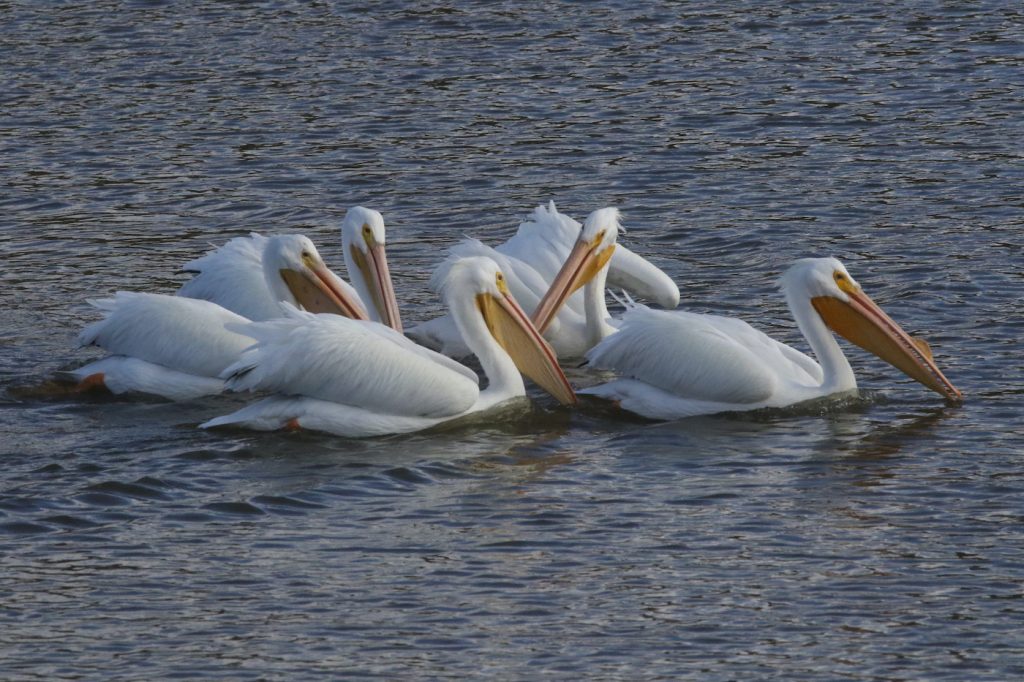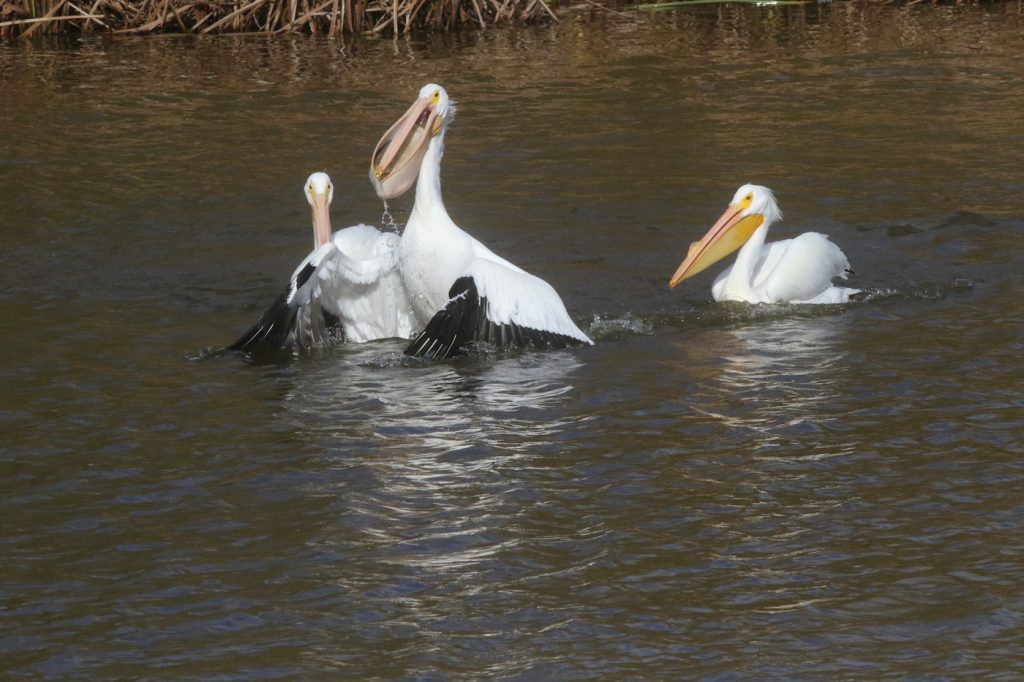Taking the Plunge

While kayaking and circumnavigating the Salton Sea’s 110 miles of coastline in California’s southeastern corner, the winter climes were a mild 75 degrees, and the salty waters were beyond silky smooth.
It was so clear I could see a massive flock of American white pelicans two miles off in the distance resting peacefully on the surface, bathing their fluffy white feathers, and plunging the shallows for briny shrimp. Eighty percent of the entire population winters in the Salton Sea enjoying those crisp cool nights and short arid days across the desert biome.
North America’s largest pelican, with a wingspan approaching nine feet, doesn’t fly out over the ocean. And they don’t divebomb fish from above like their cousin, the California brown pelican. Instead, while sitting on the water they simply plunge with their yellowish beaks.
They breed and nest in northern Montana and into parts of Canada, but once winter approaches, that Arctic air sends them migrating southward. Not all of them make it as far south as the Salton Sea. In California, they find plenty of winter havens along the way seeking refuge in lakes, bays, and estuaries in places like Morro Bay, Cachuma and Oso Flaco lakes, and Elkhorn Slough.
Rafting Up
The American white pelicans looked so relaxed, as they roosted and preened on a floating raft of pickleweed inside Morro Bay. The ebb and flow of tidal surge had done its job, powerful enough to rip apart a thick raft of estuarian flora.
It was so thick that it could house at least 20 very plump white pelicans. It didn’t matter in what direction the raft was going, they were simply content peacefully drifting with the tides. When I came upon them, the raft was gradually drifting in the direction of Morro Rock.
I readied my kayak and made an easy launch on the eastside of the bay. Gently paddling in their direction, I pulled out my 300mm lens from my drybag as the bow of my kayak eased up on the edge of the raft of pickleweed. Now I was connected to the raft, slowly drifting north, the pelicans not caring at all that they had a hitchhiker attached to their aquatic platform.
I fired off several frames as they furiously preened their lily-white feathers. As we drifted along, several more American white pelicans joined the fray. It became roosting room only, so I pushed the raft with my paddle, and watched these migrants float northward.
In Sync
It appeared like synchronized swimming. Five American white pelicans were working together, corralling fish in the shallows of Oso Flaco Lake, a freshwater lake tucked away in the Oceano Dunes, just south of Pismo Beach.
A sturdy boardwalk crosses over the lake with bull thrushes swaying on either side of it, the ocean breeze filtering through across the freshwater lake. It’s a fine vantage point for spotting some of the 200-plus bird species, resident and migratory birds sharing the simmering, protected waters surrounded in thick riparian habitat.

American white pelicans work together to corral fish in the shallows of Oso Flaco Lake 
A fish fills the throat pouch of an American white pelican
As I rounded a bend in the boardwalk, I could see a blur of creamy white through the swaying bull thrushes. American white pelicans were swimming in sync, side by side, in a half-moon-shaped formation, and then plunged their yellow beaks like swords into the shallows. Everything appeared synchronized. Their beaks sliced through the water simultaneously, then their tail feathers pointed upward, water filtering through as they lifted their heads and beaks out of the water full of baitfish.
There was an instance where on one synchronized plunge, one of the pelicans secured a larger fish the size of a carp. The pelican made several attempts to swallow its catch, but it got stuck in its throat pouch. The pelican became despondent and separated itself from the other four pelicans, the fish protruding through its yellow throat pouch. As time went on the pelican merely sat on the surface of the water showing very little activity. Meanwhile, another white pelican flew in, landing on its wide webbed feet, skiing to a halt right next to its counterparts. Immediately, a brand-new quintet formed, and they commenced with more synchronized fishing.
As the afternoon wore on, the white pelicans made several sweeps on the northside of the boardwalk, continuing to leave the despondent pelican alone, the fish still bulging through its pouch.
Around the lake they scoured for fish, and then one of the pelicans scooped up another larger fish, possibly a Pacific staghorn sculpin. This time, two other pelicans tried to take it away, and as they jumped on its back, the pelican that secured the fish threw its head back, pointing its beak skyward, straining its throat pouch to gulp the fish. It appeared as if the catch filled the entire pouch. After several attempts, the fish was thoroughly swallowed, and synchronized fishing continued uninterrupted on Oso Flaco Lake.







